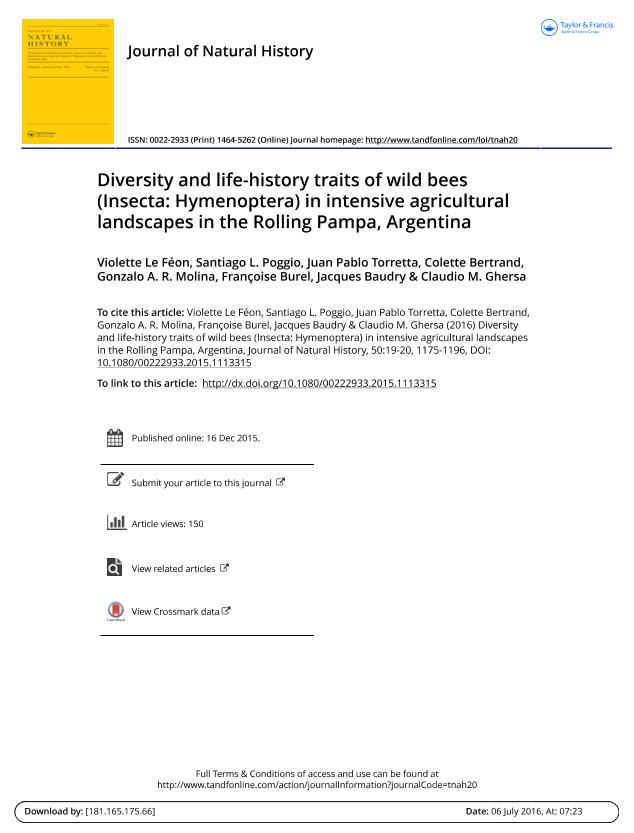Mostrar el registro sencillo del ítem
dc.contributor.author
Le Féon, Violette
dc.contributor.author
Poggio, Santiago Luis

dc.contributor.author
Torretta, Juan Pablo

dc.contributor.author
Bertrand, Colette
dc.contributor.author
Molina, Gonzalo Alberto Roman

dc.contributor.author
Burel, Françoise
dc.contributor.author
Baudry, Jacques
dc.contributor.author
Ghersa, Claudio Marco

dc.date.available
2018-05-04T18:42:15Z
dc.date.issued
2016-12
dc.identifier.citation
Le Féon, Violette; Poggio, Santiago Luis; Torretta, Juan Pablo; Bertrand, Colette; Molina, Gonzalo Alberto Roman; et al.; Diversity and life-history traits of wild bees (Insecta: Hymenoptera) in intensive agricultural landscapes in the Rolling Pampa, Argentina; Taylor & Francis Ltd; Journal of Natural History; 50; 19-20; 12-2016; 1175-1196
dc.identifier.issn
0022-2933
dc.identifier.uri
http://hdl.handle.net/11336/44197
dc.description.abstract
The decline of bees is a major concern due to their vital role inpollinating many crops and wild plants. Some regions in SouthAmerica, and especially the Pampas, are amongst those parts ofthe world where stressors of bee populations have been littlestudied. The Pampas has been intensively transformed for agriculture,being presently one of the most productive areas of agriculturalcommodities in the world. Here, we aim to provide firstinsights on the taxonomic and functional composition of beeassemblages in the Rolling Pampa, the most intensively managedpart of the Pampas. Soybean (herbicide-tolerant genetically modifiedvarieties) is the predominant crop in this region. Bees weresampled with coloured pan traps. Sampling points were locatedon field margins in either the cropped or the semi-natural grasslandarea of a farmland site devoted to annual cropping. A total of2384 individuals were caught, representing 33 taxa [mainly (morpho)species]. The subgenus Lasioglossum (Dialictus) largely dominatedcaptures (78% of the total abundance) and was relativelyabundant in the entire study area, suggesting that some speciesare likely to reach their ecological requirements in cropped areas.No-till fields and field margins may provide large areas for thesebelow-ground nesting species, while their polylectic food preferencesallow them to collect pollen on a wide range of plantspecies, among them possibly soybean. On the contrary, the richnessand the abundance of other taxa were higher in the seminaturalarea than in the cropped area. Among them, abovegroundnesting or oil-collecting species, which have more specialisednesting and floral requirements, were highly associated withthe semi-natural area. Our findings highlight the large dominanceof L. (Dialictus) species in this highly intensively managed landscape,and the urgent need of preserving semi-natural habitats tomaintain species-rich and functionally diverse bee communities inthe Pampas.
dc.format
application/pdf
dc.language.iso
eng
dc.publisher
Taylor & Francis Ltd

dc.rights
info:eu-repo/semantics/openAccess
dc.rights.uri
https://creativecommons.org/licenses/by-nc-sa/2.5/ar/
dc.subject
Functional Diversity
dc.subject
Herbicide-Tolerant, Genetically Modified Soybean
dc.subject
Lasioglossum (Dialictus)
dc.subject
No-Tillage
dc.subject
Wild Bees
dc.subject.classification
Otras Ciencias Biológicas

dc.subject.classification
Ciencias Biológicas

dc.subject.classification
CIENCIAS NATURALES Y EXACTAS

dc.title
Diversity and life-history traits of wild bees (Insecta: Hymenoptera) in intensive agricultural landscapes in the Rolling Pampa, Argentina
dc.type
info:eu-repo/semantics/article
dc.type
info:ar-repo/semantics/artículo
dc.type
info:eu-repo/semantics/publishedVersion
dc.date.updated
2018-04-27T18:54:37Z
dc.identifier.eissn
1464-5262
dc.journal.volume
50
dc.journal.number
19-20
dc.journal.pagination
1175-1196
dc.journal.pais
Reino Unido

dc.journal.ciudad
Londres
dc.description.fil
Fil: Le Féon, Violette. Consejo Nacional de Investigaciones Científicas y Técnicas. Oficina de Coordinación Administrativa Parque Centenario. Instituto de Investigaciones Fisiológicas y Ecológicas Vinculadas a la Agricultura. Universidad de Buenos Aires. Facultad de Agronomía. Instituto de Investigaciones Fisiológicas y Ecológicas Vinculadas a la Agricultura; Argentina. Institut National de la Recherche Agronomique; Francia
dc.description.fil
Fil: Poggio, Santiago Luis. Consejo Nacional de Investigaciones Científicas y Técnicas. Oficina de Coordinación Administrativa Parque Centenario. Instituto de Investigaciones Fisiológicas y Ecológicas Vinculadas a la Agricultura. Universidad de Buenos Aires. Facultad de Agronomía. Instituto de Investigaciones Fisiológicas y Ecológicas Vinculadas a la Agricultura; Argentina
dc.description.fil
Fil: Torretta, Juan Pablo. Consejo Nacional de Investigaciones Científicas y Técnicas. Oficina de Coordinación Administrativa Parque Centenario; Argentina. Universidad de Buenos Aires. Facultad de Agronomía. Departamento de Recursos Naturales y Ambiente. Cátedra de Botánica Agrícola; Argentina
dc.description.fil
Fil: Bertrand, Colette. Institut National de la Recherche Agronomique; Francia
dc.description.fil
Fil: Molina, Gonzalo Alberto Roman. Consejo Nacional de Investigaciones Científicas y Técnicas. Oficina de Coordinación Administrativa Parque Centenario. Instituto de Investigaciones Fisiológicas y Ecológicas Vinculadas a la Agricultura. Universidad de Buenos Aires. Facultad de Agronomía. Instituto de Investigaciones Fisiológicas y Ecológicas Vinculadas a la Agricultura; Argentina
dc.description.fil
Fil: Burel, Françoise. Universite de Rennes I; Francia. Centre National de la Recherche Scientifique; Francia
dc.description.fil
Fil: Baudry, Jacques. Institut National de la Recherche Agronomique; Francia
dc.description.fil
Fil: Ghersa, Claudio Marco. Consejo Nacional de Investigaciones Científicas y Técnicas. Oficina de Coordinación Administrativa Parque Centenario. Instituto de Investigaciones Fisiológicas y Ecológicas Vinculadas a la Agricultura. Universidad de Buenos Aires. Facultad de Agronomía. Instituto de Investigaciones Fisiológicas y Ecológicas Vinculadas a la Agricultura; Argentina
dc.journal.title
Journal of Natural History

dc.relation.alternativeid
info:eu-repo/semantics/altIdentifier/url/https://www.tandfonline.com/doi/full/10.1080/00222933.2015.1113315
dc.relation.alternativeid
info:eu-repo/semantics/altIdentifier/doi/http://dx.doi.org/10.1080/00222933.2015.1113315
Archivos asociados
